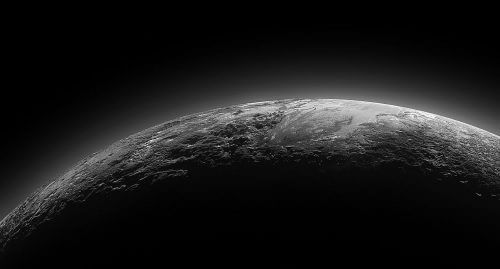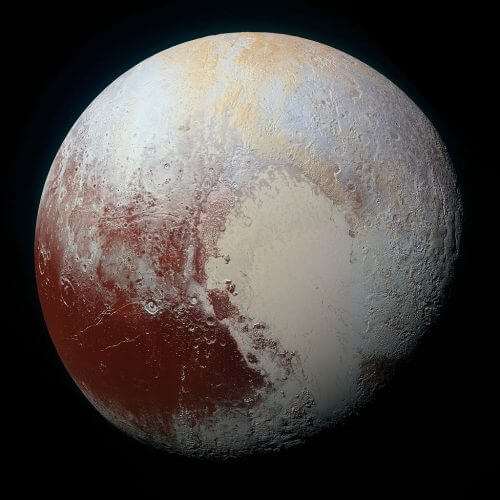New findings from the study of the dwarf and distant planet Pluto

X-ray emission
The combination of the measurements of New Horizons and the Chandra Space Telescope resulted in a new and surprising discovery. It turned out that Pluto emits x-rays. This type of radiation is created when the solar wind moves into neutral atoms or into magnetic fields emitted by planets and comets.
Pluto's environment cannot be used as conductive to produce this radiation and Pluto itself has no magnetic field. Its atmosphere is too thin and is losing matter at a slower rate than expected. So where does the x-ray come from?
In the measurements made by the Chandra space telescope in 2014 and 2015, only 7 photons were counted moving from Pluto during two days of observation(1). Several possibilities have been put forward to explain the phenomenon. It turned out that Pluto's interaction with the solar wind had a different energetic pattern than expected. Pluto may have a longer and wider gaseous tail than observed by the spacecraft, creating a wider potential contact area with the solar wind. Another possibility is that interplanetary magnetic fields focus more particles than the solar wind in the space around Pluto (2).
atmosphere

For years astronomers have wondered why Pluto's temperature, 203 degrees below zero, is 30 degrees lower than predicted. It turned out to be related to the haze made of hydrocarbonate particles that are a product of the breakdown of gases such as methane and nitrogen in the upper atmosphere.
In the photographs taken by New Horizons you can see many layers of fog in the atmosphere. They originate from chemical reactions in the upper atmosphere, a place where ultraviolet radiation from the sun ionizes nitrogen and methane. A reaction takes place between them that creates hydrocarbonate particles with a diameter of nanometers that move downwards. On their way to the ground, they stick to each other and form clumps that keep growing until they reach the ground and stick to it. The cooling mechanism also includes heat absorption by the fog particles. So they emit infrared radiation back into space and cool the atmosphere. The result is that the temperature is between 203 degrees Celsius below zero instead of 174 degrees Celsius below zero (3).
nitrogen and other gases

As it turned out, there are different types of glaciers on the surface of Pluto. The most common is also the most volatile (volatile) nitrogen. The nitrogen goes into a gas state, at a temperature of 235 degrees below zero, by way of sublimation it creates the atmosphere that is in some sort of balance with the nitrogen ice reservoir on the ground in Sputnik Planum. Other glaciers are methane found in the entire northern hemisphere except for the equatorial region and the CO ice found only in small amounts - Sputnik Planum. According to a model proposed at the bottom of this basin, the atmospheric pressure increases and the temperature of the frost is higher than outside the basin, which allows the nitrogen ice to condense into ice. Simulations showed that the nitrogen inevitably accumulates in the basin and creates the permanent nitrogen reservoir observed by the spacecraft. According to this model, there is no need for an internal nitrogen reservoir to explain the ice in this basin as suggested in previous cases (4).
In Sputnik Planum the temperatures and sunlight together create an environment where nitrogen is dominant in the Northern Hemisphere at high latitudes. Beyond 55 degrees latitude, the summer sunlight appears to have stripped most of the nitrogen from the ground, leaving vast plains of methane ice in the Arctic. The influence of the Sputnik Planum basin reaches the highest places in the atmosphere. The volatile gases in the atmosphere move upwards and the photochemical reactions create new carbon and nitrogen compounds. These create a layer of haze that reaches up to a height of more than 200 km from the ground, higher than thought because the temperatures at these heights are too hot to allow condensation. Instead, a rain of dust coming from space can serve as nuclei around which the fog particles accumulate as clumps, they grow and grow and take on a spherical shape and finally reach the ground and cover it until warming begins and are lifted again (5). This is a process reminiscent of the water cycle in our world.
clouds
Some of the researchers of the photographs stated that they noticed 7 bright formations that could be clouds. If this is indeed the case, it means that Pluto's climate is much more complex than previously thought. All these formations are located at a low altitude from the ground and have a similar length, a few kilometers to tens of kilometers each. They are all found in the terminator, the area separating the day and night areas. According to one of the released models, they contain acetylene, ethane and hydrogen cyanide (6).
Sources
- Christopher CrockettX rays mystery shrouds Pluto, 7.11.2016
- NASA mystery: Scientists baffled by Pluto's intense x-ray emissions. No natural means for emitting them, 18.9.2016
- Pluto's hydrocarbon haze helps keep the dwarf planet cooler than expected
- Shedding light on Pluto's glaciers, 21.9.2016
- Alexandra Witze, Icy heart could be key to Pluto's strange geology, 21.10.2016
- Charles O. Choi, “Clouds on Pluto? Dwarf planet's weather gets weirder"19.10.2016
See more on the subject on the science website:
- New research sheds light on the formation of the tectonic belt around Pluto's moon Charon
- Pluto - summary of findings: chapters א, ב, ג, ד
- Charon, Pluto's moon
- Pluto's moons

One response
It is very strange that even at Pluto, which is very far from the sun, at its very low temperature, it is possible to speak of an active weather of winds, clouds, haze and rains (of nitrogen and carbon compounds).
Thanks for an interesting article!
Yehuda